
I fitted an ATF cooler line pressure sensor and found a very simple way adapt and monitor TC fluid output (transmission ATF outlet) with a K- Thermocouple for almost instant indication of temperature change.
With the selector in D, ATF temperature immediately started to rise, shift to P and temperature immediately started to drop. Selected 2nd, vehicle braked and RPM increased for a second to around 1200 RPM, TC output temperature makes a straight vertical rise on the graph. These K-thermos are so sensitive and fast that during testing just blowing in the direction of one from 6 feet away caused the temps to spike. Now I can definitely catch a sudden spike in TC output temperature. This is critical to catch one of the known flaws that can develop over time in the 5AT.
ATF cooler line pressure was 26psi in P at idle @15°C and 5psi with hot ATF. Lowest reading was 0.1psi in gear hot at idle. This is the area that has been identified as one of the causes of unexplained TC overheating failures in the 5AT. In other words, flow rate drops below 0.7 GPM and down to zero in fault/flaw condition. The recommendation I have seen published is to never let flow rate drop below 0.8 GPM @ Hot idle in gear. NOTE: I'm measuring cooler line pressure at the FLUID RETURN INLET, this is torwards the rear of the transmission: That's AFTER most of the ATF hose, the Filter, Cooler and Bypass valve.
The pressure sensor I use has electronics and a signal amplifier built into the small stainless steel sensor housing. Response time is quoted <1ms, accuracy +/- 1% FS and cost is $23.00. Its fast enough to show a momentary spike or pressure drop when the shift lever is moved between P-D-R etc, especially when I sample the sensor at 100ms interval: A few years back something like this was over $400.
One thing that happens when you spend time looking and measuring just one area of a vehicle, it causes you to dig a little deeper into the operation and interpretation of measured results and data. Further reading into pressure drop over a fluid line would indicate that pressure will be different towards the end of the line compared to the start. Logic would indicate that measuring pressure close to the outlet, where flow is increasing, will give the lowest reading - providing the outlet is not restricted - and this is where I'm measuring external cooler line pressure.
It's also a logical assumption that as fluid viscosity lowers from heat (thins) there will be less pressure required to flow the same volume of fluid through the line. It follows that any restriction to flow "after the measuring point" will also flow more - hot thin - fluid with less back pressure/resistance to flow - the closer you measure to the unrestricted outlet, the lower the pressure.
After thinking long and hard about the first round of readings, I feel that pressure readings I'm seeing are more an indication of max/min pressure at that measuring location and not true outlet pressure generated by and through the TC. I'm likely reading around 5psi less that measuring directly at the Transmission ATF outlet (input of the external cooler line). I could shift the Sensor but there is no room for it at the outlet, and really there is an easier way to tell if I have insufficient flow rate, although I plan to directly test ATF outlet pressure in a few weeks anyway.
Once I establish the normal pressure at this location I will have an indicator of any fault/loss in the future and by adding a low pressure alarm (with allowance for Hot idle) I will know instantly of any ATF hose failure of restriction - before any damage can be done.
Again, it's flow rate that's important in the cooler line, the flow rate "HOT in gear" in a newly rebuilt and modified transmission is quoted at only 0.8 GPM, so pressure may indicate 0 in this one instance in the location I'm measuring, however flow rate certainly is not low. The proof? That fast response thermocouple I mounted directly in the fluid stream right at the outlet of the TC/ATF transmission outlet, and later tests (shown on a graph at the end of this page).
Any loss of flow below 0.8 GPM in gear will cause an immediate and massive rise in TC outlet temperature, and will show as fluid outlet temperatures spikes the instant flow restarts/increases with rising RPM (above 1300 RPM in most faulty units). Temperatures from 250°F to 360°F have been measures at the TC outlet with low or no flow after ATF flow resumption.
IE: If flow had reduced to the point of causing an already hot (from normal driving) TC to overheat from TC slip while stationary at idle in gear, the temp sensor will show it. Sufficient fluid flow at low pressure is the key, unfortunately quality flow sensors that can run at temps above 100C are dam expensive.
Testing data by transmission people at Sonnax confirmed readings posted by owners and revealed ATF running at 205°F around town once fully warm and 230°F on hot days in traffic. Other tests on a transmission with a replacement TC and mods for Cooler circuit flow (flow at or above 0.8 GPM) still showed ATF temps reaching 235°F in traffic on Hot days. Adding a larger external cooler in series with the Radiator tank exchanger held temperatures down to around 205°F to 210°F.
QUOTE TC rebuilder: You may be wondering why 20-25 psi was the sweet spot for testing the Honda converters, rather than the 40 psi that worked on other units. Honda does not use the typical two-path apply and release circuit that is used in the 4R100, 4L60-E, 5R55E, and many other applications Instead, it uses a three path oil circuit that incorporates a converter bypass valve like the circuits found in some front wheel drive Fords; eg. CD4E, AX4N, and AX4S. For this reason the circuit is especially sensitive to outside variables such as restricted coolers and cross leaks. Honda converter charge oil comes from the charge oil circuit of the main regulator valve. With this design, charge pressure is often only half of what line pressure would be. This is why the lockup clutches of the Honda converters need to be tested at 20 to 25 psi instead of the 40 psi that is used on other units.
A 40 minute drive with a mix of 60kmh (37mph) hilly 80kmh (50mph) and 100kmh (62mph) with sudden drops to 60kmh and stop start traffic. Outside temperature is not that high at around 25°C (77°F). Temperature of vehicle block at start up in the shed was around 16°C.
These k-thermos need a special input device to allow for junction temperature variations and other parameters. There is a small CHIP available for around $12.00. It converts a K-Thermo output signal to 10mv per deg output. You could read this on a standard $10 multimeter. You can also purchase a small readymade board with screw connectors. More on these devices and my measuring setup.
The graph below sampled all sensors once per second and during the sample time the Pressure and ATF sensors were read 800 times each, the average of the total number of readings is calculated and displayed. I can change the update time down to 100 milliseconds and update the graph and meter display every 100ms when needed, however logged data files get quite large.
Onto the Graph: Once again compressed into one screen:
With the selector in D, ATF temperature immediately started to rise, shift to P and temperature immediately started to drop. Selected 2nd, vehicle braked and RPM increased for a second to around 1200 RPM, TC output temperature makes a straight vertical rise on the graph. These K-thermos are so sensitive and fast that during testing just blowing in the direction of one from 6 feet away caused the temps to spike. Now I can definitely catch a sudden spike in TC output temperature. This is critical to catch one of the known flaws that can develop over time in the 5AT.
ATF cooler line pressure was 26psi in P at idle @15°C and 5psi with hot ATF. Lowest reading was 0.1psi in gear hot at idle. This is the area that has been identified as one of the causes of unexplained TC overheating failures in the 5AT. In other words, flow rate drops below 0.7 GPM and down to zero in fault/flaw condition. The recommendation I have seen published is to never let flow rate drop below 0.8 GPM @ Hot idle in gear. NOTE: I'm measuring cooler line pressure at the FLUID RETURN INLET, this is torwards the rear of the transmission: That's AFTER most of the ATF hose, the Filter, Cooler and Bypass valve.
The pressure sensor I use has electronics and a signal amplifier built into the small stainless steel sensor housing. Response time is quoted <1ms, accuracy +/- 1% FS and cost is $23.00. Its fast enough to show a momentary spike or pressure drop when the shift lever is moved between P-D-R etc, especially when I sample the sensor at 100ms interval: A few years back something like this was over $400.
One thing that happens when you spend time looking and measuring just one area of a vehicle, it causes you to dig a little deeper into the operation and interpretation of measured results and data. Further reading into pressure drop over a fluid line would indicate that pressure will be different towards the end of the line compared to the start. Logic would indicate that measuring pressure close to the outlet, where flow is increasing, will give the lowest reading - providing the outlet is not restricted - and this is where I'm measuring external cooler line pressure.
It's also a logical assumption that as fluid viscosity lowers from heat (thins) there will be less pressure required to flow the same volume of fluid through the line. It follows that any restriction to flow "after the measuring point" will also flow more - hot thin - fluid with less back pressure/resistance to flow - the closer you measure to the unrestricted outlet, the lower the pressure.
After thinking long and hard about the first round of readings, I feel that pressure readings I'm seeing are more an indication of max/min pressure at that measuring location and not true outlet pressure generated by and through the TC. I'm likely reading around 5psi less that measuring directly at the Transmission ATF outlet (input of the external cooler line). I could shift the Sensor but there is no room for it at the outlet, and really there is an easier way to tell if I have insufficient flow rate, although I plan to directly test ATF outlet pressure in a few weeks anyway.
Once I establish the normal pressure at this location I will have an indicator of any fault/loss in the future and by adding a low pressure alarm (with allowance for Hot idle) I will know instantly of any ATF hose failure of restriction - before any damage can be done.
Again, it's flow rate that's important in the cooler line, the flow rate "HOT in gear" in a newly rebuilt and modified transmission is quoted at only 0.8 GPM, so pressure may indicate 0 in this one instance in the location I'm measuring, however flow rate certainly is not low. The proof? That fast response thermocouple I mounted directly in the fluid stream right at the outlet of the TC/ATF transmission outlet, and later tests (shown on a graph at the end of this page).
Any loss of flow below 0.8 GPM in gear will cause an immediate and massive rise in TC outlet temperature, and will show as fluid outlet temperatures spikes the instant flow restarts/increases with rising RPM (above 1300 RPM in most faulty units). Temperatures from 250°F to 360°F have been measures at the TC outlet with low or no flow after ATF flow resumption.
IE: If flow had reduced to the point of causing an already hot (from normal driving) TC to overheat from TC slip while stationary at idle in gear, the temp sensor will show it. Sufficient fluid flow at low pressure is the key, unfortunately quality flow sensors that can run at temps above 100C are dam expensive.
Testing data by transmission people at Sonnax confirmed readings posted by owners and revealed ATF running at 205°F around town once fully warm and 230°F on hot days in traffic. Other tests on a transmission with a replacement TC and mods for Cooler circuit flow (flow at or above 0.8 GPM) still showed ATF temps reaching 235°F in traffic on Hot days. Adding a larger external cooler in series with the Radiator tank exchanger held temperatures down to around 205°F to 210°F.
QUOTE TC rebuilder: You may be wondering why 20-25 psi was the sweet spot for testing the Honda converters, rather than the 40 psi that worked on other units. Honda does not use the typical two-path apply and release circuit that is used in the 4R100, 4L60-E, 5R55E, and many other applications Instead, it uses a three path oil circuit that incorporates a converter bypass valve like the circuits found in some front wheel drive Fords; eg. CD4E, AX4N, and AX4S. For this reason the circuit is especially sensitive to outside variables such as restricted coolers and cross leaks. Honda converter charge oil comes from the charge oil circuit of the main regulator valve. With this design, charge pressure is often only half of what line pressure would be. This is why the lockup clutches of the Honda converters need to be tested at 20 to 25 psi instead of the 40 psi that is used on other units.
A 40 minute drive with a mix of 60kmh (37mph) hilly 80kmh (50mph) and 100kmh (62mph) with sudden drops to 60kmh and stop start traffic. Outside temperature is not that high at around 25°C (77°F). Temperature of vehicle block at start up in the shed was around 16°C.
These k-thermos need a special input device to allow for junction temperature variations and other parameters. There is a small CHIP available for around $12.00. It converts a K-Thermo output signal to 10mv per deg output. You could read this on a standard $10 multimeter. You can also purchase a small readymade board with screw connectors. More on these devices and my measuring setup.
The graph below sampled all sensors once per second and during the sample time the Pressure and ATF sensors were read 800 times each, the average of the total number of readings is calculated and displayed. I can change the update time down to 100 milliseconds and update the graph and meter display every 100ms when needed, however logged data files get quite large.
Onto the Graph: Once again compressed into one screen:
The interesting thing to note is the display from 29 minutes to 32 minutes. I stopped, waited for traffic to clear and accelerated quite quickly to 62mph: So at 29.3 minutes I was stopped and waiting, the sharp rise in pressure at 29.4 is 1st gear, there are 3 dips at the top of the spike for each gear and a sharp drop to 7psi as it shifted into 5th. You can see an immediate spike in TC temperatures as the acceleration to 62 mph occurred, followed by a quick drop in temperatures between 29.7m and 32 minute marks as it cruised in 5th. Cooler output dropped to 60C quite quickly followed by ATF TC output temperatures (it's a big cooler) following that I dropped quickly to an off ramp and stopped at traffic lights. The remainder of the drive was start stop traffic, despite the fact that I was travelling slowly and stopping quite often, cooler output temps held at around 73°C. No cooler fan but the AC fans were running.
I measured the OEM transmission ATF sensor via OBD2 and it did what I expected:
1: Matched the TC outlet temperature whenever the TC is locked or not slipping for a short period of time.
2: After a minute or so it always matches TC outlet temperature when the trans in "N" or "P".
3: Most of the time you could add around 5°C to the "constant cruise output" of the cooler outlet temp sensor and be close.
I measured the OEM transmission ATF sensor via OBD2 and it did what I expected:
1: Matched the TC outlet temperature whenever the TC is locked or not slipping for a short period of time.
2: After a minute or so it always matches TC outlet temperature when the trans in "N" or "P".
3: Most of the time you could add around 5°C to the "constant cruise output" of the cooler outlet temp sensor and be close.

Another thing to note from this preliminary graph is the slow arc down of pressure in direct relation to increasing ATF temperature. If you draw a line across the tops of the PSI reading it becomes very apparent. We are talking TC pump output pressure not internal mainline pressure. In most cases where tests were able to be carried out on a failed transmission, mainline pressure was still been within acceptable limits. Most low clutch apply pressure faults are due to o-ring leakage (age and heat related), wear in the valve body and other VB conditions, wear in the shaft case bearings and leakage from the TC shaft seal and other various internal TC-cooler line seals and valves.
A few thoughts:
Because of the design of the TC and cooler valve circuit (internally) and the low running pressure in this circuit (measured by TC and Trans experts when investigating why TC failures were occurring in rebuilds and higher mileage units) the viscosity index of ATF at high temperature becomes critical. This implies that the quality of ATF and it's viscosity change with age is important in older transmissions.
Again reinforcing the need to perform regular 1 x 3L changes once known fresh ATF is established in the transmission. IMHO it's imperative to control the temperature of ATF in the 5AT and keep it at or below 87°C - 190°F and not run it at 220°F, 240°F as some owners often report.
At the moment I'm running a mix with a Viscosity close to DW-1 and DW-1 is a lower viscosity fluid than Z1. Is this another reason why some people have trouble when switching to DW-1 as they do when trying a non OEM fluid of similar viscosity? And even more trouble when changing to an even lower viscosity fluid in older transmissions. In other words, high Viscosity fluid like Z1 is masking a problem that's waiting just around the corner for the owner that not even Z1 will stop.
Other Honda owners (vehicles without a Hockey Puck Warmers) with OEM radiator tank coolers, have published some data. Readings up to 245°F have been reported at the TC outlet under harsh conditions. Some have been surprised at bulk heat build up over time in traffic. Another problem is the way the temperature probes were connected, usually by taping the sensor to the ATF Metal line or Hose. This approach considerably slows sensor response to ATF temperature changes (especially if taped to the hose), and depending on how well the sensor and hose are insulated from external air and heat, it effects accuracy to varying degrees.
There were, in the past, people stating that it was imperative the existing OEM tank (or trans mounted PUCK) cooler/warmer was left in circuit. They claimed that it stabilised ATF and that Honda knew what they were doing, Sound familiar? Well I can confirm that the OEM warmer/cooler is relatively ineffective at doing this because of its size. It may have a SMALL stabilizing impact on ATF temps BUT over a "very long time period". It cannot (does not) control rapid increases in BULK ATF temperature. Others have suggested that reading ATF outlet (TC exit) temperatures is of little benefit and the "Holy Grail" is monitoring bulk sump temperature: In a standard transmission this maybe so, but in a 5AT ! - once again IMHO their uninformed opinion is wrong: KNOWN TC heat problems combined with known internal cooler circuit flow flaws in the 5AT indicate that ATF (TC) outlet monitoring is an important tool ALONG with bulk ATF sump temperature in picking up early problems and TC health - problems that don't normally show in ATF sump temperature until it's way too late.
Other tests I have completed show rapid increases in TC ATF fluid of 10° and 20° in a second or two, the OEM cooler is totally useless at doing ANYTHING with these variations, it may help stabilise temps but only if the vehicle is cruising at one speed for 10 to 20 minutes at a time. There is less ATF volume in the 5AT compared with other transmissions and cooler outlet (returned ATF) temperatures show up after a short time in TC outlet temperature - a slow acting small cooler/warmer is not what I want in my vehicle behind this 5AT.
A few thoughts:
Because of the design of the TC and cooler valve circuit (internally) and the low running pressure in this circuit (measured by TC and Trans experts when investigating why TC failures were occurring in rebuilds and higher mileage units) the viscosity index of ATF at high temperature becomes critical. This implies that the quality of ATF and it's viscosity change with age is important in older transmissions.
Again reinforcing the need to perform regular 1 x 3L changes once known fresh ATF is established in the transmission. IMHO it's imperative to control the temperature of ATF in the 5AT and keep it at or below 87°C - 190°F and not run it at 220°F, 240°F as some owners often report.
At the moment I'm running a mix with a Viscosity close to DW-1 and DW-1 is a lower viscosity fluid than Z1. Is this another reason why some people have trouble when switching to DW-1 as they do when trying a non OEM fluid of similar viscosity? And even more trouble when changing to an even lower viscosity fluid in older transmissions. In other words, high Viscosity fluid like Z1 is masking a problem that's waiting just around the corner for the owner that not even Z1 will stop.
Other Honda owners (vehicles without a Hockey Puck Warmers) with OEM radiator tank coolers, have published some data. Readings up to 245°F have been reported at the TC outlet under harsh conditions. Some have been surprised at bulk heat build up over time in traffic. Another problem is the way the temperature probes were connected, usually by taping the sensor to the ATF Metal line or Hose. This approach considerably slows sensor response to ATF temperature changes (especially if taped to the hose), and depending on how well the sensor and hose are insulated from external air and heat, it effects accuracy to varying degrees.
There were, in the past, people stating that it was imperative the existing OEM tank (or trans mounted PUCK) cooler/warmer was left in circuit. They claimed that it stabilised ATF and that Honda knew what they were doing, Sound familiar? Well I can confirm that the OEM warmer/cooler is relatively ineffective at doing this because of its size. It may have a SMALL stabilizing impact on ATF temps BUT over a "very long time period". It cannot (does not) control rapid increases in BULK ATF temperature. Others have suggested that reading ATF outlet (TC exit) temperatures is of little benefit and the "Holy Grail" is monitoring bulk sump temperature: In a standard transmission this maybe so, but in a 5AT ! - once again IMHO their uninformed opinion is wrong: KNOWN TC heat problems combined with known internal cooler circuit flow flaws in the 5AT indicate that ATF (TC) outlet monitoring is an important tool ALONG with bulk ATF sump temperature in picking up early problems and TC health - problems that don't normally show in ATF sump temperature until it's way too late.
Other tests I have completed show rapid increases in TC ATF fluid of 10° and 20° in a second or two, the OEM cooler is totally useless at doing ANYTHING with these variations, it may help stabilise temps but only if the vehicle is cruising at one speed for 10 to 20 minutes at a time. There is less ATF volume in the 5AT compared with other transmissions and cooler outlet (returned ATF) temperatures show up after a short time in TC outlet temperature - a slow acting small cooler/warmer is not what I want in my vehicle behind this 5AT.
I was wondering how much pressure the Torque Convertor (TC) could actually produce when hot at idle.
In other words - is the linear decline of ATF cooler line pressure with ATF heat a result of Viscosity change ALONE? thereby allowing the same volume of fluid to flow with little pressure compared to required pressure with cold ATF - or is the TC also losing some pressure with heat?
As stated before - the Honda TC and valve design results in normal TC ATF exit pressure being around 25psi to 30psi and there is a flaw and age related fault condition that can cause the TC and external cooler circuit to be bypassed when ATF is HOT while stopped and idling in gear ("D" in traffic etc.) And because ATF exit pressure is directly proportional to engine RPM and fluid Viscosity, it is quite low at Hot Idle in gear in any case.
ATF cooler hose is softer when hot and I'm able to squeeze enough to almost cut of flow with my fingers. I did this the other day at the HOT ATF outlet to see if I could feel fluid flow through the line (yes I could) and there was sufficient pressure to force the fluid through the narrowed hose, this also coincided with the Pressure gauge showing a drop in pressure to almost zero (hose clamped before the P-gauge) - however there was still fluid flow - my assumption of lower pressure being registered closer to the cool ATF inlet port appears to be correct - I'll soon prove it when I move the gauge to the ATF outlet port for some tests.
Squeezing the ATF return hose - after the inline Pressure gauge - resulted in a jump from 3psi to almost 30psi on the gauge and being generated by the TC at idle with 80°C fluid. There was no sign of the internal cooler bypass valve trying to bypass the TC or external cooler circuit even under this condition
NOTE: This graph is generated by my software reading the Pressure gauge every100ms (10 times per second) and logging each 100ms reading.
Graph: Cool ATF return hose squeezed tight (by hand) almost 30 PSI generated.
In other words - is the linear decline of ATF cooler line pressure with ATF heat a result of Viscosity change ALONE? thereby allowing the same volume of fluid to flow with little pressure compared to required pressure with cold ATF - or is the TC also losing some pressure with heat?
As stated before - the Honda TC and valve design results in normal TC ATF exit pressure being around 25psi to 30psi and there is a flaw and age related fault condition that can cause the TC and external cooler circuit to be bypassed when ATF is HOT while stopped and idling in gear ("D" in traffic etc.) And because ATF exit pressure is directly proportional to engine RPM and fluid Viscosity, it is quite low at Hot Idle in gear in any case.
ATF cooler hose is softer when hot and I'm able to squeeze enough to almost cut of flow with my fingers. I did this the other day at the HOT ATF outlet to see if I could feel fluid flow through the line (yes I could) and there was sufficient pressure to force the fluid through the narrowed hose, this also coincided with the Pressure gauge showing a drop in pressure to almost zero (hose clamped before the P-gauge) - however there was still fluid flow - my assumption of lower pressure being registered closer to the cool ATF inlet port appears to be correct - I'll soon prove it when I move the gauge to the ATF outlet port for some tests.
Squeezing the ATF return hose - after the inline Pressure gauge - resulted in a jump from 3psi to almost 30psi on the gauge and being generated by the TC at idle with 80°C fluid. There was no sign of the internal cooler bypass valve trying to bypass the TC or external cooler circuit even under this condition
NOTE: This graph is generated by my software reading the Pressure gauge every100ms (10 times per second) and logging each 100ms reading.
Graph: Cool ATF return hose squeezed tight (by hand) almost 30 PSI generated.
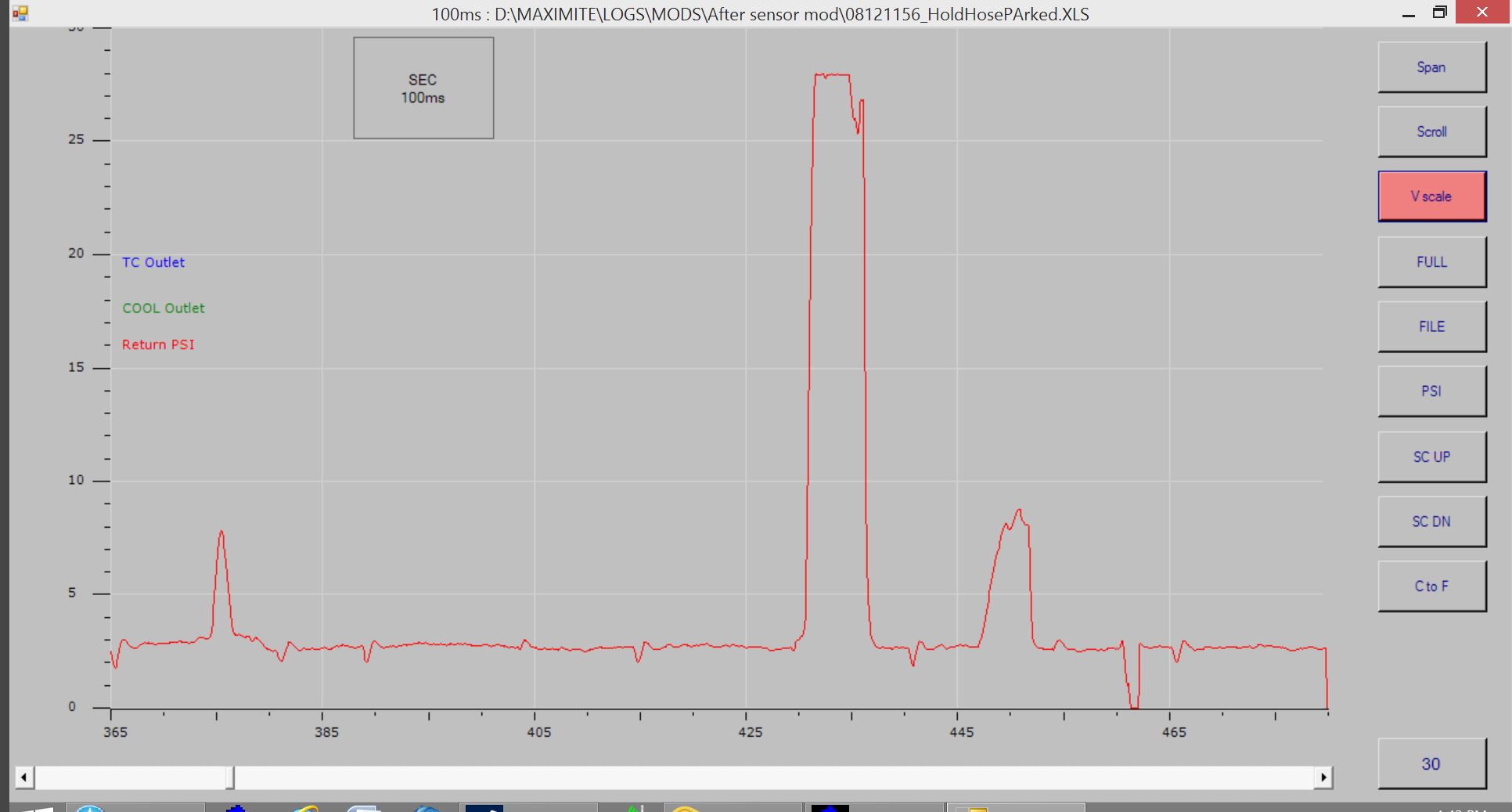
IN GEAR - HOT IDLE ATF 85°C. Squeezing the ATF return hose - after the inline pressure gauge - resulted in a jump from 0 psi to 25 psi on the gauge. This indicates that although pressure measured at this point is reading zero under these conditions, the TC is still pushing fluid and will generate 25 psi if needed to push fluid through the cooler line. Again, there was no sign of the internal cooler bypass valve fault attempting to bypass the TC or external cooler circuit even under this condition.
You have to ask yourself - What would it be like with ATF @ 120°C / 248°F ?
Graph: Cool ATF return hose squeezed tight (by hand) IN GEAR IDLE HOT (85°C) 25 PSI generated.
You have to ask yourself - What would it be like with ATF @ 120°C / 248°F ?
Graph: Cool ATF return hose squeezed tight (by hand) IN GEAR IDLE HOT (85°C) 25 PSI generated.
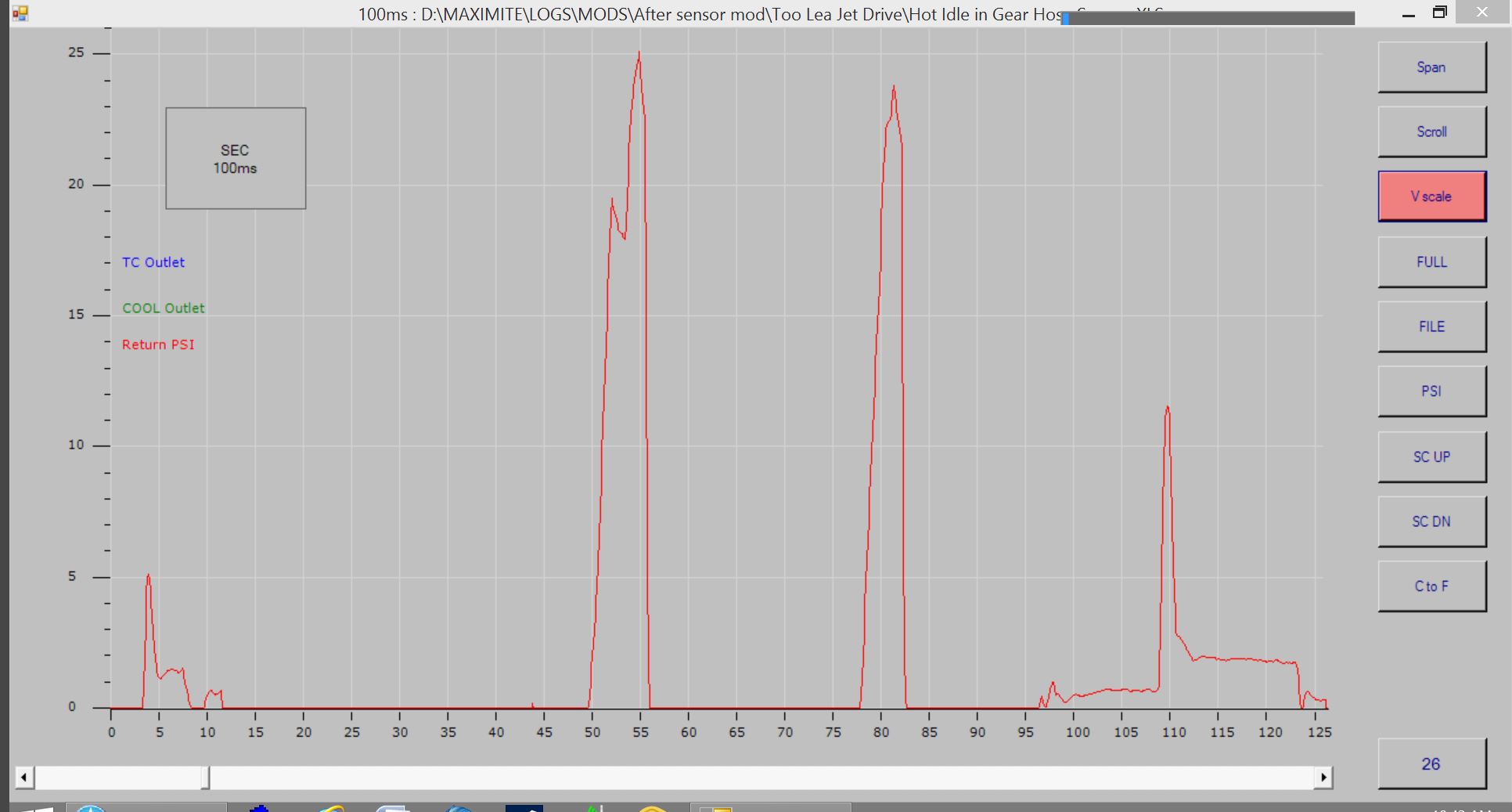
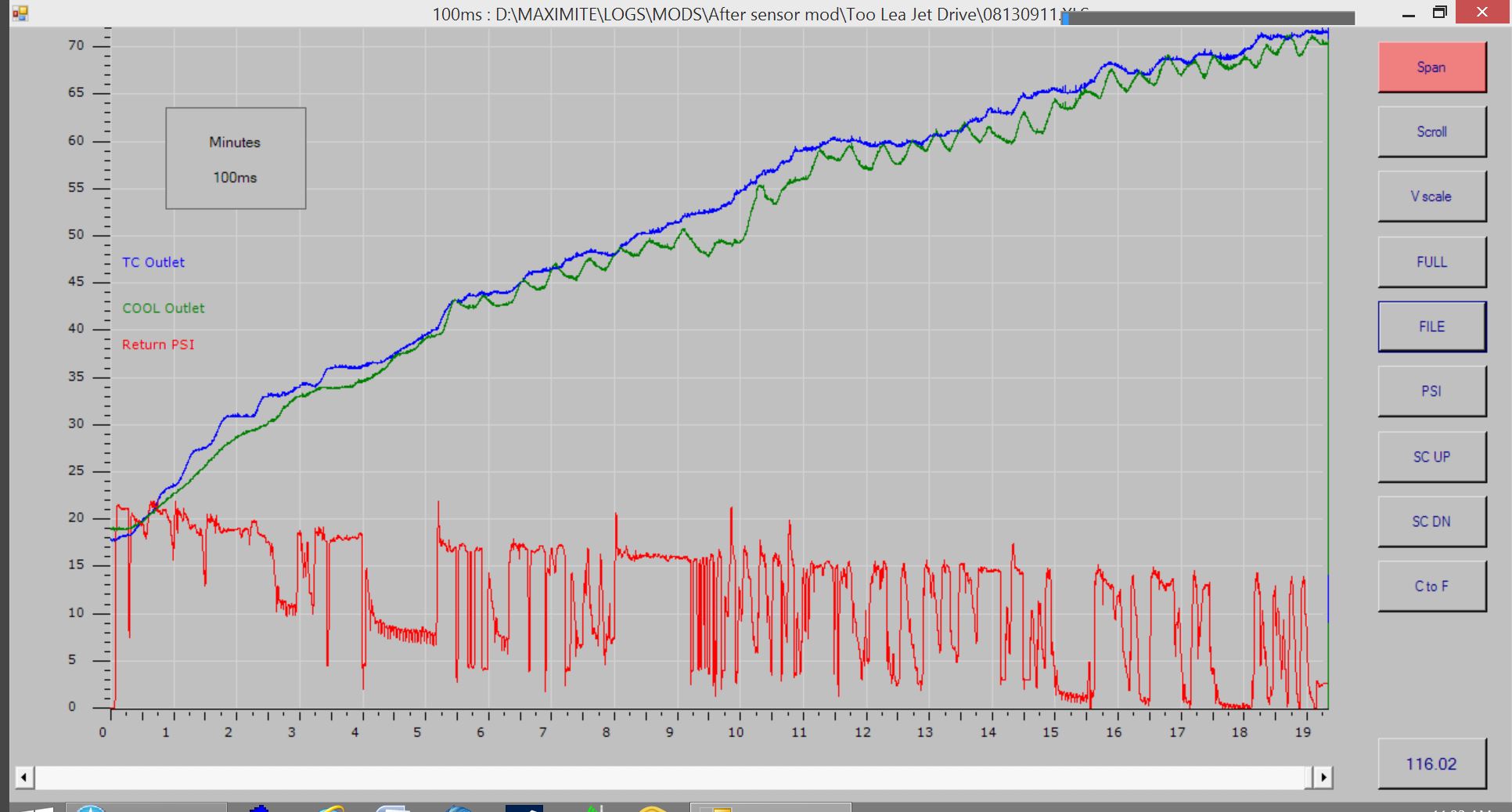
Once again in the Graph below you can again see the slow arc down of pressure in direct relation to increasing ATF temperature. If you draw a line across the tops of the PSI reading it becomes very apparent. As I stasted eariler, this is TC pump output pressure not internal mainline pressure. Compared to the eariler graph @ 1sec, this time the sensor sample rate is 100ms.
Spikes in the Cooler line pressure readings:
1: The flat sections are from moving in various gears (hence RPM) changes as does pressure.
2: Sharp downward spikes are from gear changes, pressure is removed from the TC as the change is made.
3: Each time the transmission shifts a gear or the Auto selector is moved, cooler line pressure drops to near zero for a second as it shifts or selects a transmission mode.
One thing I noticed is that ATF heats faster in D3 at slow speeds than it does in D at the same speed, even though flow rate is a third or less in D and RPM are just above idle. It appears that faster heating of ATF in D3 at slow speeds may just be down to TC lockup, although the 5AT still locks in 3rd - but only under the right conditions - it attempts to lock constantly in 5th at slow speed, even though there is partial and full lock occurring, there is enough to reduce TC I/O speed and therefore TC fluid coupling heat. Constant lock/unlock in 5th at slow speeds does not generate enough heat in the TC lock clutch to heat the fluid but it still heats the clutch and wears it out over time until one day you find a flashing D and a TC fail to lock code is set.
The AC fan has a big impact on the performance: The cooler outlet rises and falls as I turn the AC and hence the AC fan on and off (while stationary). However even moving at 20mph (no AC) started to bring the temps down, some had suggested far higher speeds were needed before sufficient air flow was attained for any noticeable change to happen.
Whenever I cruised in 4th, 5th - even at speeds as low as 36mph the air flow immediately moved the cooler outlet temperature down - However that's a bit misleading as ATF flow is much lower in 4th and 5th, therefore the cooler has time to remove more heat from the lower volume of fluid flow, but again the result still appears within a second in ATF outlet temperature, however once flow rate increased with speed, temps came down VERY quickly.
1: The flat sections are from moving in various gears (hence RPM) changes as does pressure.
2: Sharp downward spikes are from gear changes, pressure is removed from the TC as the change is made.
3: Each time the transmission shifts a gear or the Auto selector is moved, cooler line pressure drops to near zero for a second as it shifts or selects a transmission mode.
One thing I noticed is that ATF heats faster in D3 at slow speeds than it does in D at the same speed, even though flow rate is a third or less in D and RPM are just above idle. It appears that faster heating of ATF in D3 at slow speeds may just be down to TC lockup, although the 5AT still locks in 3rd - but only under the right conditions - it attempts to lock constantly in 5th at slow speed, even though there is partial and full lock occurring, there is enough to reduce TC I/O speed and therefore TC fluid coupling heat. Constant lock/unlock in 5th at slow speeds does not generate enough heat in the TC lock clutch to heat the fluid but it still heats the clutch and wears it out over time until one day you find a flashing D and a TC fail to lock code is set.
The AC fan has a big impact on the performance: The cooler outlet rises and falls as I turn the AC and hence the AC fan on and off (while stationary). However even moving at 20mph (no AC) started to bring the temps down, some had suggested far higher speeds were needed before sufficient air flow was attained for any noticeable change to happen.
Whenever I cruised in 4th, 5th - even at speeds as low as 36mph the air flow immediately moved the cooler outlet temperature down - However that's a bit misleading as ATF flow is much lower in 4th and 5th, therefore the cooler has time to remove more heat from the lower volume of fluid flow, but again the result still appears within a second in ATF outlet temperature, however once flow rate increased with speed, temps came down VERY quickly.
Initial tests with One Pressure sensor in the ATF return line.
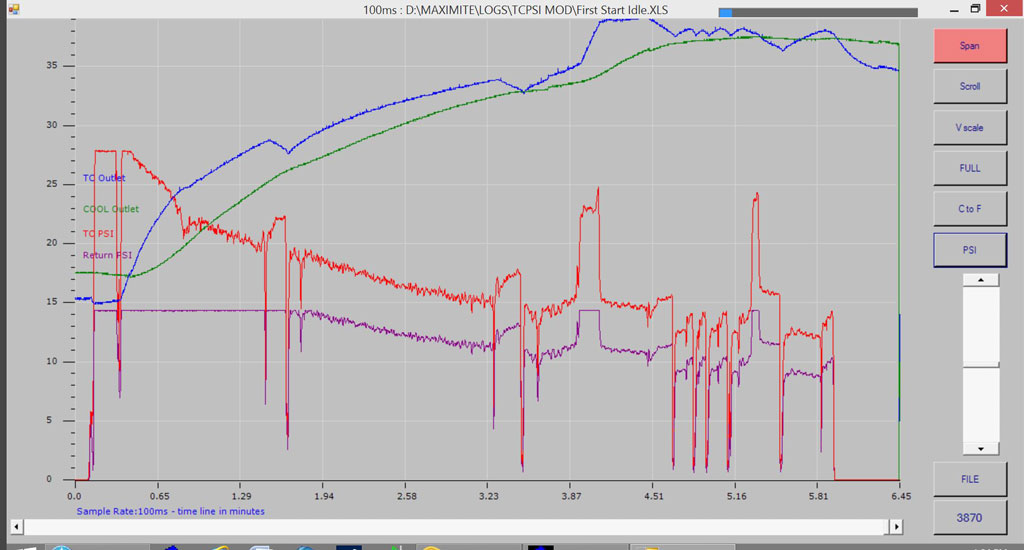
First graph with Dual Pressure sensors and modified OEM Cooler Bypass adaptor.
Cold start: Note that Return Pressure is a 15psi sensor and is flat-lined at 14.6 psi for the first 1.67 seconds. TC outlet pressure is a 30psi sensor and is also flat-lined at 28psi also due to a low 5 volt supply rail which will soon to be fixed
Note again how quickly pressure drops due to ATF viscosity change with heat, even at 35°C (95°F). Pressure difference is simply due to the 15psi sensors location close to the end of the ATF return input. In another graph it will be seen that when pressure readings are below 3psi - low flow rate - there is virtually no difference in psi between the sensors.
Peaks and troughs in the pressure readings: Very sharp short spikes are a result of gear selection N-1-2-D3-D vehicle is stationary the whole time in this graph. Longer rise and dips are RPM changes - in this case holding the vehicle braked in gear and bringing RPM up to 1200 RPM to see if the temperature sensor directly in the TC exit ATF flow can catch the sudden rise in TC temperature (it can).
This and other graphs highlight the fact that a temperature sensor mounted on a metal pipe CANNOT catch short temperature spikes in TC output temperature, notice how the cooler output sensor is completely smoothed out and delayed in any change AND this is not being influenced by the cooler as it is completely bypassed, there is 2 feet of hose separating the two sensors at this temperature. The cooler out sensor is bonded to a small aluminium pipe that is completely insulated from everything except the AT fluid, it is mounted in the rubber ATF return line and the complete assembly is encased in foil insulation, mounting a sensor to normal steel ATF lines that are attached to the transmission case would be even worse.
Just after 3.9 minutes (above) I bring the engine up to 1200 RPM in 2nd stationary, you can see TC output immediately rise.
Note again how quickly pressure drops due to ATF viscosity change with heat, even at 35°C (95°F). Pressure difference is simply due to the 15psi sensors location close to the end of the ATF return input. In another graph it will be seen that when pressure readings are below 3psi - low flow rate - there is virtually no difference in psi between the sensors.
Peaks and troughs in the pressure readings: Very sharp short spikes are a result of gear selection N-1-2-D3-D vehicle is stationary the whole time in this graph. Longer rise and dips are RPM changes - in this case holding the vehicle braked in gear and bringing RPM up to 1200 RPM to see if the temperature sensor directly in the TC exit ATF flow can catch the sudden rise in TC temperature (it can).
This and other graphs highlight the fact that a temperature sensor mounted on a metal pipe CANNOT catch short temperature spikes in TC output temperature, notice how the cooler output sensor is completely smoothed out and delayed in any change AND this is not being influenced by the cooler as it is completely bypassed, there is 2 feet of hose separating the two sensors at this temperature. The cooler out sensor is bonded to a small aluminium pipe that is completely insulated from everything except the AT fluid, it is mounted in the rubber ATF return line and the complete assembly is encased in foil insulation, mounting a sensor to normal steel ATF lines that are attached to the transmission case would be even worse.
Just after 3.9 minutes (above) I bring the engine up to 1200 RPM in 2nd stationary, you can see TC output immediately rise.
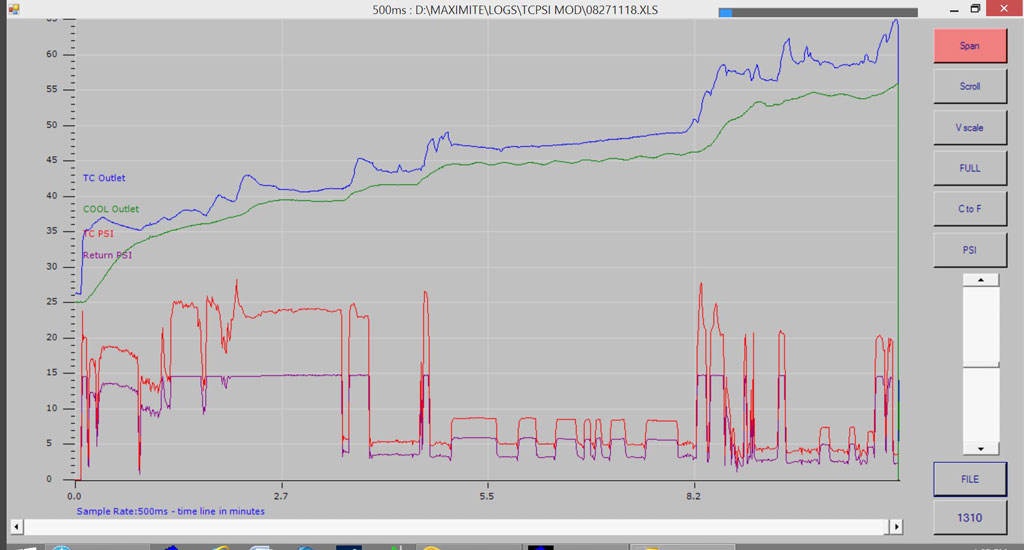
This is the first drive with the new setup, started shortly after the previous cold start graph. Once again 15psi sensor is flat-lined.
Notice TC output temps rise with moderate acceleration while pipe mounted cooler temperature probe delays and flattens any change, however in fairness the cooler bypass valve is now starting to crack open and dampen the temperature rise.
The graph below is hot idle 760 RPM - no air flow except for the AC fan. From 274 to 310 seconds the transmission is in D and although pressure shows zero there is still ATF flow through the TC and external cooler, (see 2nd and 3rd graphs on this page) at 310 seconds I bring engine up to 1200rpm to create more heat and then place the transmission in N and again bring up RPM to force a high ATF flow rate - TC output temperature increases by only 2°C and then drops, this is repeated again with the same result - there is sufficient flow rate at idle to keep the TC happy and cool whilst stopped in traffic in gear.
Notice TC output temps rise with moderate acceleration while pipe mounted cooler temperature probe delays and flattens any change, however in fairness the cooler bypass valve is now starting to crack open and dampen the temperature rise.
The graph below is hot idle 760 RPM - no air flow except for the AC fan. From 274 to 310 seconds the transmission is in D and although pressure shows zero there is still ATF flow through the TC and external cooler, (see 2nd and 3rd graphs on this page) at 310 seconds I bring engine up to 1200rpm to create more heat and then place the transmission in N and again bring up RPM to force a high ATF flow rate - TC output temperature increases by only 2°C and then drops, this is repeated again with the same result - there is sufficient flow rate at idle to keep the TC happy and cool whilst stopped in traffic in gear.
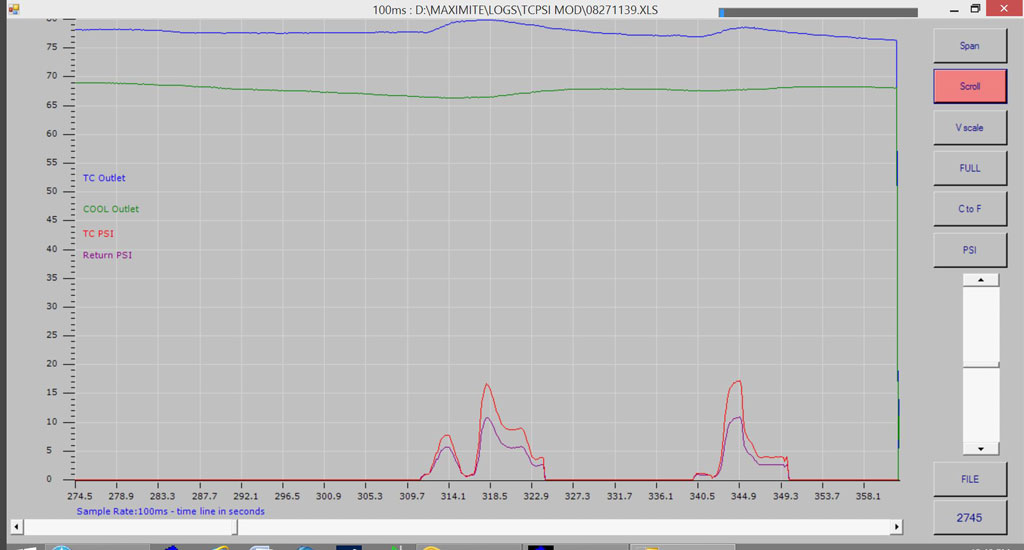
Below is a graph with correct 5 volt supply to the Pressure sensors. Notice at startup 0.0 to 0.56 how the Sensor in the cool outlet cannot track fast ATF temperature changes due to hysteresis created by the indirect mounting of the probe to the fluid. Both sensors are identical and both locations see the same ATF temperature until around 40°C when the temperature bypass valve starts to slightly crack open.
At 0.28 minutes the vehicle is placed into Drive. Vehicle is idling @ 720 rpm and stationary until 2.24 where it's placed into Park, RPM raised for a second in Park at 2.34.
Note again the Return PSI reading is via a 15psi sensor so it's flat-lined most of the time in this graph.
The drop in pressure as fluid thins with heat is clearly seen here and we only get to 30°C.
At 0.28 minutes the vehicle is placed into Drive. Vehicle is idling @ 720 rpm and stationary until 2.24 where it's placed into Park, RPM raised for a second in Park at 2.34.
Note again the Return PSI reading is via a 15psi sensor so it's flat-lined most of the time in this graph.
The drop in pressure as fluid thins with heat is clearly seen here and we only get to 30°C.
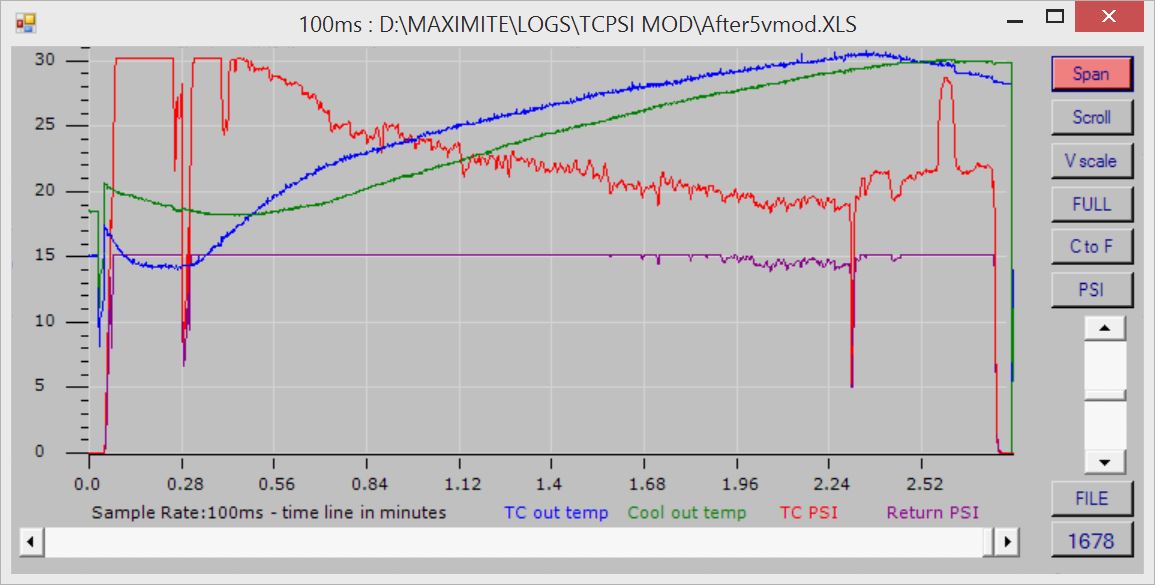
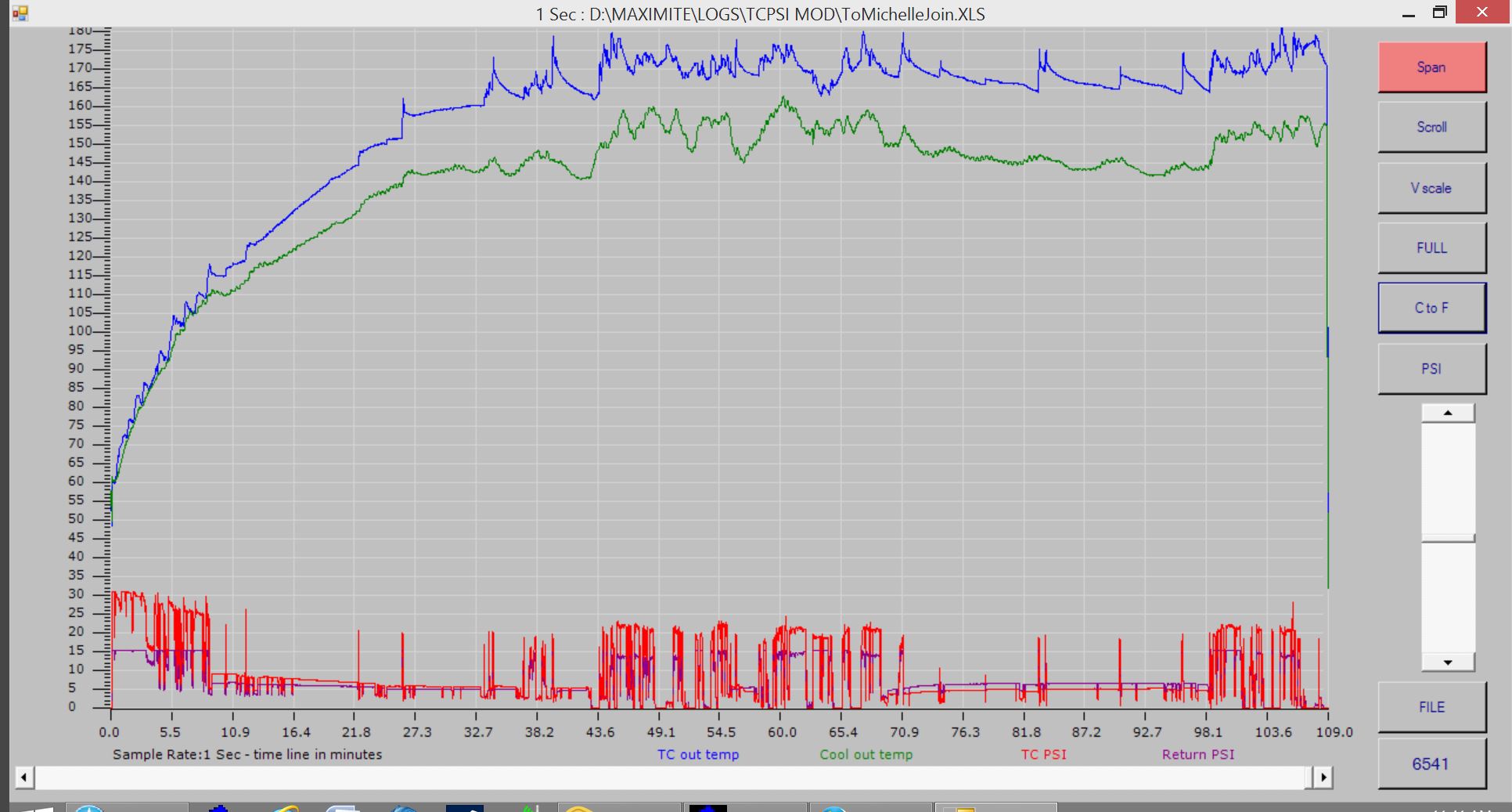
Two hour drive - mixture of slow traffic and 70MPH cruise with TC locked. Overall fairly even temps once the cooler bypass opens.
As said many times before, there will be a large temperature divergence across the cooler as flow rate slows with pressure drop. With higher flow rates the outlet temperature is also higher (less temp diff across the cooler) but transmission bulk temperature stays the same - as it should. The OEM transmission sensor was hovering around 170 °F. Outside temperature got 82 °F.
I've shown the graph in °F this time.
As said many times before, there will be a large temperature divergence across the cooler as flow rate slows with pressure drop. With higher flow rates the outlet temperature is also higher (less temp diff across the cooler) but transmission bulk temperature stays the same - as it should. The OEM transmission sensor was hovering around 170 °F. Outside temperature got 82 °F.
I've shown the graph in °F this time.
High red PSI is traffic and lots of low gear acceleration. Flat periods at around 5psi are 70mph cruise with the occasional psi spike being a gear change/acceleration for various reasons.
Driving in hilly terrain, climbing to 1400ft with a major part of that climb in 4 minutes @ 50 mph. I's a very steep grade and when descending I lock the transmission in 3rd, I'm often on the brakes to hold speed at the posted limit - ears pop 3 to 4 times on the way down. Outside temp was 59°F at the start of the day, around 78°F on the climb, very fine sunny weather.
As a side note: I have been searching for data and going over other posted graphs from Honda owners for the past few weeks, with what I have measured along with results from my pressure testing, I noticed posted graph and data plots often showed ATF doing things in the 4AT/5AT cooler circuit that are impossible - I will point out my reservations on that data later.
BTW I'm in no way degrading the effort or results of these owners nor saying anything against these owners! They have done the best they could with what they had at the time, just as I'm trying to do - None had the advantage of cooler line pressure sensors - they were making educated guesses as to what was happening in the external cooler circuit and in the absence of available information were also underestimating loss of accuracy, response flattening and delays caused by mounting methods used for the sensors.
Back to the climb: I went 1/2 way up the very steep section with the vehicle in Drive, something I don't normally do on this or any long steep climb, but I wanted to test TC generated heat between 5th, 4th and 3rd on this climb.
NOTE: Transmission ATF / TC outlet is a 1/2 inch from the K thermo temperature head - this tiny sensor in inside an adaptor housing that removes the OEM warmer, the sensor is completely insulated from the surrounding metal housing - ATF sprays / flows straight at the sensor, it's flooded and instantly shows TC outlet ATF temperature with +/- 2.2° accuracy, the sensor head is rated to 1300°F.
As the vehicle started climbing this very steep road, ATF from the TC went from 65°F to 212°F in under 2 minutes, transmission was in Drive and it auto shifted from 5th to 4th. Engine had enough RPM and plenty of torque to easily hold 50mph on part throttle in 4th, engine management and TCU were not interested in downshifting to 3rd.
At 36 minutes (on the graph) I reach a short flat stretch of road for 15 seconds, RPM drops as it shifts up to 5th - [B]Notice how fast the K-Thermo responds:[/B] First to a short sudden drop in TC pressure (no flow over the sensor) as the up-shift takes place, then to the reduced TC load as lower temperature bulk ATF flows at a very low rate through the cooler circuit and over the temperature sensor, this appears to lower TC ATF temperature by 20°F in a very short time - did I mention the sensor is insulated from EVERYTHING but the ATF - proof for any doubters.
I then change into 3rd before the start of the next steep climb, from that point on the vehicle stays in 3rd gear, still climbing the same steep grade @ 50mph @ around 3,400 RPM, TC exit temperature rises with higher ATF flow (3rd gear) then stabilises, ATF temperature comes down fairly quickly as heat output from the TC starts to drop and is cooled by bulk ATF low temperature, ATF temps drops 20°F before the grade flattens out and once again I shift into Drive on a more gentle slope, further steep climbs are made in 3rd and the temperature averages 180°F for the remainder of the climb.
Less slippage and therefore less heat generated by the TC because of increased engine RPM and a gear ratio that better matches engine speed (TC Input) to TC Output speed, resulting in less rotational speed difference across the Torque Convertor (TC).
As a side note: I have been searching for data and going over other posted graphs from Honda owners for the past few weeks, with what I have measured along with results from my pressure testing, I noticed posted graph and data plots often showed ATF doing things in the 4AT/5AT cooler circuit that are impossible - I will point out my reservations on that data later.
BTW I'm in no way degrading the effort or results of these owners nor saying anything against these owners! They have done the best they could with what they had at the time, just as I'm trying to do - None had the advantage of cooler line pressure sensors - they were making educated guesses as to what was happening in the external cooler circuit and in the absence of available information were also underestimating loss of accuracy, response flattening and delays caused by mounting methods used for the sensors.
Back to the climb: I went 1/2 way up the very steep section with the vehicle in Drive, something I don't normally do on this or any long steep climb, but I wanted to test TC generated heat between 5th, 4th and 3rd on this climb.
NOTE: Transmission ATF / TC outlet is a 1/2 inch from the K thermo temperature head - this tiny sensor in inside an adaptor housing that removes the OEM warmer, the sensor is completely insulated from the surrounding metal housing - ATF sprays / flows straight at the sensor, it's flooded and instantly shows TC outlet ATF temperature with +/- 2.2° accuracy, the sensor head is rated to 1300°F.
As the vehicle started climbing this very steep road, ATF from the TC went from 65°F to 212°F in under 2 minutes, transmission was in Drive and it auto shifted from 5th to 4th. Engine had enough RPM and plenty of torque to easily hold 50mph on part throttle in 4th, engine management and TCU were not interested in downshifting to 3rd.
At 36 minutes (on the graph) I reach a short flat stretch of road for 15 seconds, RPM drops as it shifts up to 5th - [B]Notice how fast the K-Thermo responds:[/B] First to a short sudden drop in TC pressure (no flow over the sensor) as the up-shift takes place, then to the reduced TC load as lower temperature bulk ATF flows at a very low rate through the cooler circuit and over the temperature sensor, this appears to lower TC ATF temperature by 20°F in a very short time - did I mention the sensor is insulated from EVERYTHING but the ATF - proof for any doubters.
I then change into 3rd before the start of the next steep climb, from that point on the vehicle stays in 3rd gear, still climbing the same steep grade @ 50mph @ around 3,400 RPM, TC exit temperature rises with higher ATF flow (3rd gear) then stabilises, ATF temperature comes down fairly quickly as heat output from the TC starts to drop and is cooled by bulk ATF low temperature, ATF temps drops 20°F before the grade flattens out and once again I shift into Drive on a more gentle slope, further steep climbs are made in 3rd and the temperature averages 180°F for the remainder of the climb.
Less slippage and therefore less heat generated by the TC because of increased engine RPM and a gear ratio that better matches engine speed (TC Input) to TC Output speed, resulting in less rotational speed difference across the Torque Convertor (TC).
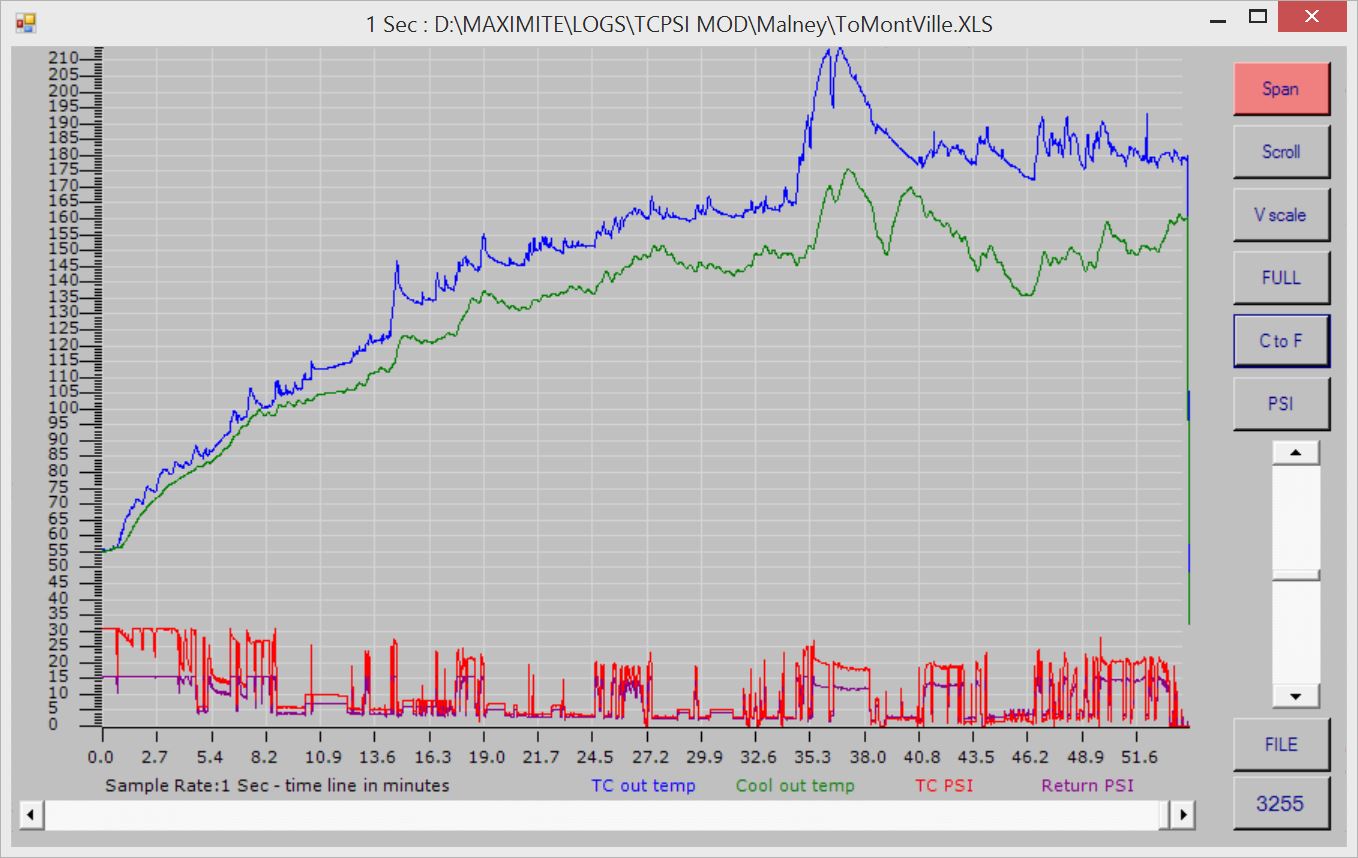
I have always overridden any automatic (428 Cobra Jet BIG BLOCK with wall to wall torque included) as I refuse to LUG any motor below 3000 RPM on this kind of grade.
Because of incorrect placement of sensors and sample rates used by owners, either by trying to fit long trip data onto a hand held display device with little memory or sample rate limitations imposed by the device itself, none of the published data shows this instant change in heat so dramatically. A lot of data posted by owners is sampled at 1 to 10 minute intervals and because of the hysteresis created by the sensor mounting methods and location, dynamic changes in ATF temperature are flattened and delayed by minutes - or completely missed.
I have climbed for longer periods with similar grades in heat wave conditions in this Honda, I'm so thankful that I have always locked it in 3rd, sometimes 2nd with this 5AT.
Other users have measured ATF temperatures of over 260°F from the TC in mountain driving. They would have spiked far hotter than what they measured because of sensor placement and read sample rate.
The other thing to note is that bulk ATF temperatures ARE NOT increasing by that much in my transmission as this big plate & fin cooler is constantly trying to hold a 20°F difference between I/O fluid ports and at the peak TC heat output is showing almost a 45°F drop across this cooler, NOTE this is one case where I will highlight the cooler Delta temperature because flow rate in this instance is VERY HIGH - Delta temperatures across a cooler at low flow rates are meaningless. Bulk sump ATF temperature is under control in this setup.
The return trip down the mountain was equally revealing and went completely against previous owner published data. There is data available from Odyssey and accord owners - again with a small "OEM fitted" front mounted cooler that supplements and is in series with the internal radiator ATF cooler or Hockey-Puck cooler. When driving downhill and when coasting in 4th or 5th with the TC locked, they reported temperature drops down to 130°F or less in some cases.
As I stated at the start, my vehicle was not coasting but in 3rd on the downhill run so the TC was still having to work, but likewise there was no big increase in temperatures as others have reported under this driving condition, TC outlet barely touched 180°F downhill under engine braking and averaged 170°F for the entire return trip. When cruising, the lowest temperature ATF went down to was 165°F before I hit a slight slope or slowed and accelerated for some other road conditions.
Because of incorrect placement of sensors and sample rates used by owners, either by trying to fit long trip data onto a hand held display device with little memory or sample rate limitations imposed by the device itself, none of the published data shows this instant change in heat so dramatically. A lot of data posted by owners is sampled at 1 to 10 minute intervals and because of the hysteresis created by the sensor mounting methods and location, dynamic changes in ATF temperature are flattened and delayed by minutes - or completely missed.
I have climbed for longer periods with similar grades in heat wave conditions in this Honda, I'm so thankful that I have always locked it in 3rd, sometimes 2nd with this 5AT.
Other users have measured ATF temperatures of over 260°F from the TC in mountain driving. They would have spiked far hotter than what they measured because of sensor placement and read sample rate.
The other thing to note is that bulk ATF temperatures ARE NOT increasing by that much in my transmission as this big plate & fin cooler is constantly trying to hold a 20°F difference between I/O fluid ports and at the peak TC heat output is showing almost a 45°F drop across this cooler, NOTE this is one case where I will highlight the cooler Delta temperature because flow rate in this instance is VERY HIGH - Delta temperatures across a cooler at low flow rates are meaningless. Bulk sump ATF temperature is under control in this setup.
The return trip down the mountain was equally revealing and went completely against previous owner published data. There is data available from Odyssey and accord owners - again with a small "OEM fitted" front mounted cooler that supplements and is in series with the internal radiator ATF cooler or Hockey-Puck cooler. When driving downhill and when coasting in 4th or 5th with the TC locked, they reported temperature drops down to 130°F or less in some cases.
As I stated at the start, my vehicle was not coasting but in 3rd on the downhill run so the TC was still having to work, but likewise there was no big increase in temperatures as others have reported under this driving condition, TC outlet barely touched 180°F downhill under engine braking and averaged 170°F for the entire return trip. When cruising, the lowest temperature ATF went down to was 165°F before I hit a slight slope or slowed and accelerated for some other road conditions.
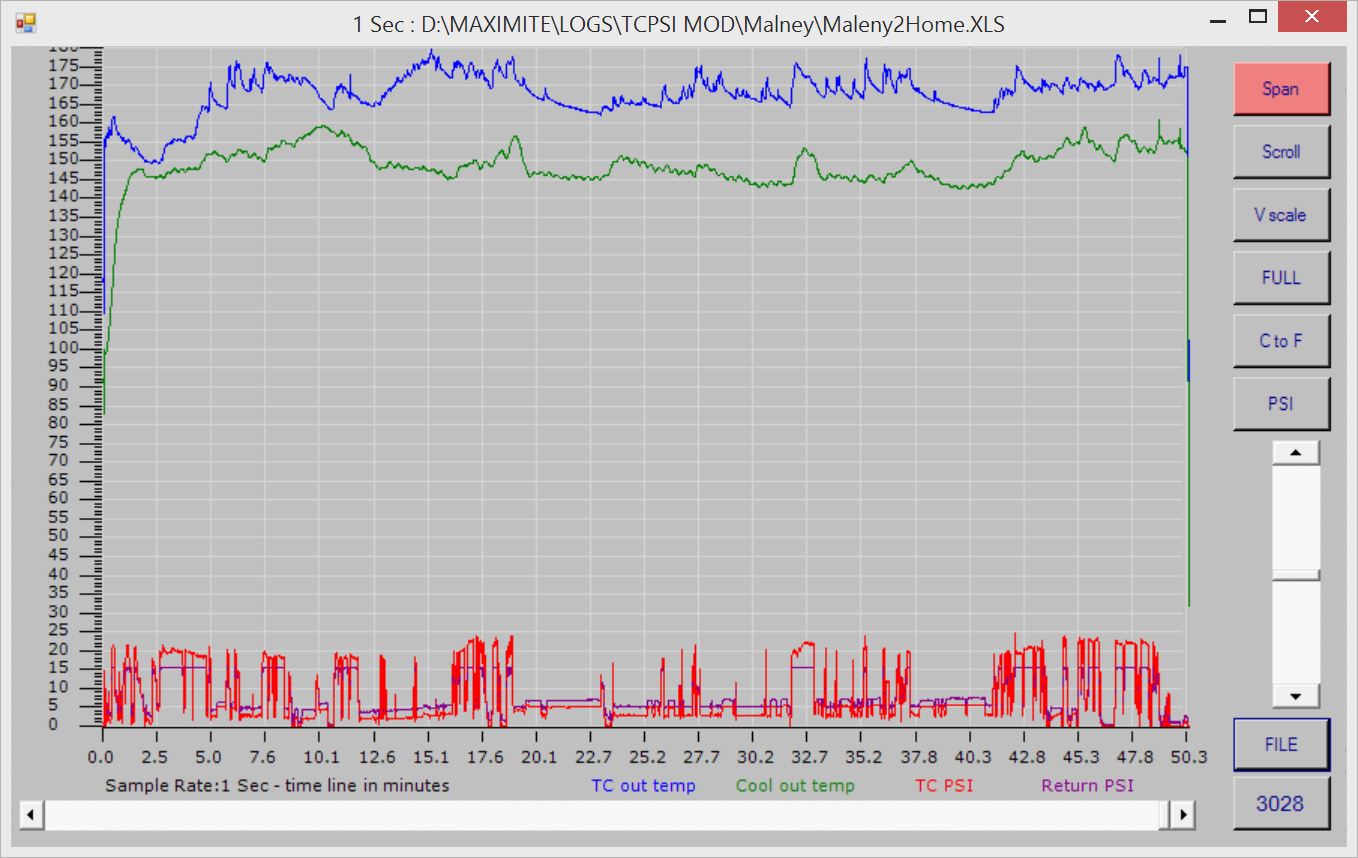
IMHO a temperature bypass on an external cooler is absolutely needed - even WITH AN OEM WARMER in circuit. Measurements I have taken on this G7 style OEM Hockey Puck cooler/warmer show that it's pretty much useless unless you live in sub zero climates, and we need someone to actually measure and prove how effective it is in this condition. Published data by other owners with OEM radiator tank mounted coolers and a small OEM external cooler show the same result - like the hockey-puck unit, the in-tank cooler appears to be too small to control anything but long term (very long term) ATF temperature variations, and only ATF temperatures that are NOT constantly changing by a significant amount.
Test data shows that when stationary in gear, the OEM cooler (Tank or Hockey Puck) can help with ATF temperatures that can climb way up over 220 °F, sometime to 260 °F, but IMHO this ONLY happens when you don't have sufficient air flow over a "suitable sized" external cooler. I have no OEM cooler - No extra cooler fan BUT the Climate control is always on in my vehicle and the AC fan creates sufficient air flow to hold ATF temperature down or make temperatures drop if the vehicle is placed into Neutral when stationary for long periods.
However there is more to this than meets the eye! The design of the 5AT and another design feature (flaw) in some AT's can cause ATF to STOP flowing through the cooler and TC circuit when ATF is hot and the vehicle is stationary in gear. However flow rate is also very low with just HOT ATF and the hotter ATF gets the lower the flow rate becomes, especially as the transmission ages. It's easy to overcome when stationary if you know it's happening, it's been flagged by transmission rebuilders before and I wonder if it's a hidden major contributor to some of the TC failure and lock codes we see as our 5AT ages?
I would be very careful with a heavy load (EG towing) in 4th and 5th without the TC locked - There will be very low flow rate through the TC and cooler in OD gears - and it rapidly decreases with heat - so what looks like moderate holding temperatures can be incorrect and artificially lowered by insufficient ATF flow needed to overcome heat being pulled away from the sensors because of compromised installation and mounting locations.
The transmission case measured 155°F after a two hour trip. At very low ATF flow rates, attaching a thermo couple to a metal ATF line that is also attached to the transmission or clamped in the engine bay can result in the thermo couple readings being influenced by the outside temperature of the pipe, it's slowly being pulled down to that 155°F case temperature instead of the internal fluid temperature.
The graph below shows just how dynamic TC fluid output is and how quickly it rises: The two spikes of ATF temperature are 3 seconds each in duration and are a result of being in D in 5th up two moderate grades at 50 mph. There was almost a 25°F spike in TC output, but an instant return to normal temperature as my bulk ATF temperature is, of course, totally unaffected by these short spikes - still you don't want overall bulk ATF temperatures at or over 220°F as some owners have measured. This is why some ATF cooling systems show high TC ATF temperatures coming down slowly over a very long time frame, overall ATF temperature is just too high to begin with.
Test data shows that when stationary in gear, the OEM cooler (Tank or Hockey Puck) can help with ATF temperatures that can climb way up over 220 °F, sometime to 260 °F, but IMHO this ONLY happens when you don't have sufficient air flow over a "suitable sized" external cooler. I have no OEM cooler - No extra cooler fan BUT the Climate control is always on in my vehicle and the AC fan creates sufficient air flow to hold ATF temperature down or make temperatures drop if the vehicle is placed into Neutral when stationary for long periods.
However there is more to this than meets the eye! The design of the 5AT and another design feature (flaw) in some AT's can cause ATF to STOP flowing through the cooler and TC circuit when ATF is hot and the vehicle is stationary in gear. However flow rate is also very low with just HOT ATF and the hotter ATF gets the lower the flow rate becomes, especially as the transmission ages. It's easy to overcome when stationary if you know it's happening, it's been flagged by transmission rebuilders before and I wonder if it's a hidden major contributor to some of the TC failure and lock codes we see as our 5AT ages?
I would be very careful with a heavy load (EG towing) in 4th and 5th without the TC locked - There will be very low flow rate through the TC and cooler in OD gears - and it rapidly decreases with heat - so what looks like moderate holding temperatures can be incorrect and artificially lowered by insufficient ATF flow needed to overcome heat being pulled away from the sensors because of compromised installation and mounting locations.
The transmission case measured 155°F after a two hour trip. At very low ATF flow rates, attaching a thermo couple to a metal ATF line that is also attached to the transmission or clamped in the engine bay can result in the thermo couple readings being influenced by the outside temperature of the pipe, it's slowly being pulled down to that 155°F case temperature instead of the internal fluid temperature.
The graph below shows just how dynamic TC fluid output is and how quickly it rises: The two spikes of ATF temperature are 3 seconds each in duration and are a result of being in D in 5th up two moderate grades at 50 mph. There was almost a 25°F spike in TC output, but an instant return to normal temperature as my bulk ATF temperature is, of course, totally unaffected by these short spikes - still you don't want overall bulk ATF temperatures at or over 220°F as some owners have measured. This is why some ATF cooling systems show high TC ATF temperatures coming down slowly over a very long time frame, overall ATF temperature is just too high to begin with.
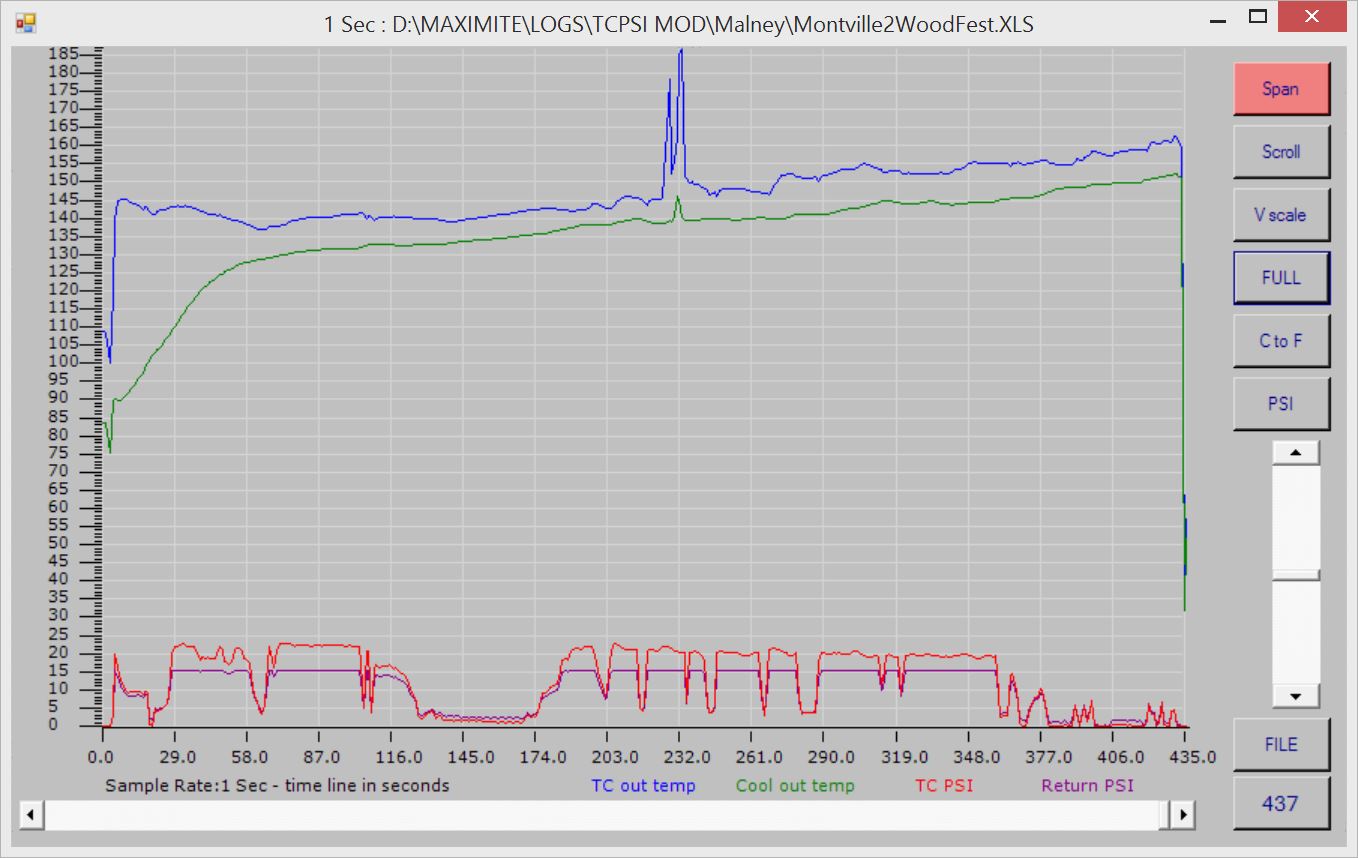
You see it repeated and preached for years on Honda forums that bulk ATF sump temperature is the only reading you need to measure or concern yourself with in a transmission - what absolute nonsense - some of these posters really should stop doing Google searches and quoting "slush box transmission search results" as Honda AT facts.
BTW After a few seconds of TC lock or when travelling along a flat road under very little throttle in D3, bulk ATF temperature in only a few degrees less than indicated TC outlet temperatures, if the TC is locked or I/O speed differences across the TC are small, then what you see is bulk ATF temperature. The transmission produces very little heat in other conditions, the only time this would not be true would be with a slipping clutch pack, but T rise would be gradual as it's a small volume of fluid coating the clutch packs that is being super heated, fried causing total ATF to be degraded quite quickly, more so if a TC is turning blue from heat - they do!
BTW After a few seconds of TC lock or when travelling along a flat road under very little throttle in D3, bulk ATF temperature in only a few degrees less than indicated TC outlet temperatures, if the TC is locked or I/O speed differences across the TC are small, then what you see is bulk ATF temperature. The transmission produces very little heat in other conditions, the only time this would not be true would be with a slipping clutch pack, but T rise would be gradual as it's a small volume of fluid coating the clutch packs that is being super heated, fried causing total ATF to be degraded quite quickly, more so if a TC is turning blue from heat - they do!










